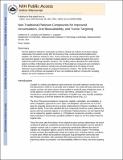Non-traditional platinum compounds for improved accumulation, oral bioavailability, and tumor targeting
Author(s)
Lovejoy, Katherine S.; Lippard, Stephen J.
DownloadLippard_Non-traditional platinum.pdf (877.2Kb)
OPEN_ACCESS_POLICY
Open Access Policy
Creative Commons Attribution-Noncommercial-Share Alike
Terms of use
Metadata
Show full item recordAbstract
The five platinum anticancer compounds currently in clinical use conform to structure–activity relationships formulated (M. J. Cleare and J. D. Hoeschele, Bioinorg. Chem., 1973, 2, 187–210) shortly after the discovery that cis-diamminedichloroplatinum(II), cisplatin, has antitumor activity in mice. These compounds are neutral platinum(II) species with two am(m)ine ligands or one bidentate chelating diamine and two additional ligands that can be replaced by water through aquation reactions. The resulting cations ultimately form bifunctional adducts on DNA. Information about the chemistry of these platinum compounds and correlations of their structures with anticancer activity have provided guidance for the design of novel anticancer drug candidates based on the proposed mechanisms of action. This article discusses advances in the synthesis and evaluation of such non-traditional platinum compounds, including cationic and tumor-targeting constructs.
Date issued
2009-10Department
Massachusetts Institute of Technology. Department of ChemistryJournal
Dalton Transactions
Publisher
Royal Society of Chemistry, The
Citation
Lovejoy, Katherine S., and Stephen J. Lippard. “Non-traditional platinum compounds for improved accumulation, oral bioavailability, and tumor targeting.” Dalton Transactions, no. 48 (2009): 10651.
Version: Author's final manuscript
ISSN
1477-9226
1477-9234